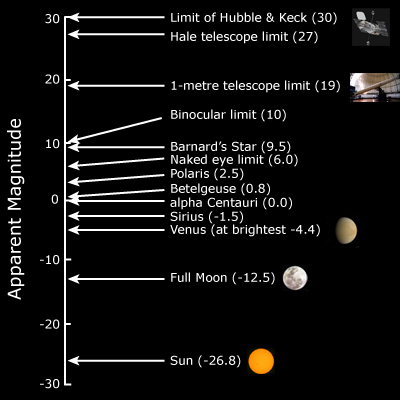
So astronomers have learned to be very careful when classifying stars according to apparent brightness. Classifying stars according to their magnitude seemed a good idea to Hipparchus (in the second century B.C.E.) when he came up with a 6-degree scale, ranging from 1, the brightest stars, to 6, those just barely visible. Unfortunately, this somewhat cumbersome and awkward system (higher magnitudes are fainter, and the brightest objects have negative magnitudes) has persisted to this day.
Hipparchus’ scale has been expanded and refined over the years. The intervals between magnitudes have been regularized, so that a difference of 1 in magnitude corresponds to a difference of about 2.5 in brightness. Thus, a magnitude 1 star is 2.5 ×2.5 ×2.5 ×2.5 ×2.5=100 times brighter than a magnitude 6 star. Because we are no longer limited to viewing the sky with our eyes, and larger apertures collect more light, magnitudes greater than (that is, fainter than) 6 appear on the scale. Objects brighter than the brightest stars may also be included, their magnitudes expressed as negative numbers. Thus the full moon has a magnitude of –12.5 and the sun, –26.8. In order to make more useful comparisons between stars at varying distances, astronomers differentiate between apparent magnitude and absolute magnitude, defining the latter, by convention, as an object’s apparent magnitude when it is at a distance of 10 parsecs from the observer. This convention cancels out distance as a factor in brightness and is therefore an intrinsic property of the star.


 The ancients believed that the stars were embedded in a distant spherical bowl and moved in unison, never changing their relative positions. We know now, of course, that the daily motion of the stars is due to the earth’s rotation. Yet the stars move, too; however, their great distance from us makes that movement difficult to perceive, except over long periods of time. A jet high in the sky, for example, can appear to be moving rather slowly, yet we know that it has to be moving fast just to stay aloft and its apparent slowness is a result of its distance. Astronomers think of stellar movement in three dimensions:
The ancients believed that the stars were embedded in a distant spherical bowl and moved in unison, never changing their relative positions. We know now, of course, that the daily motion of the stars is due to the earth’s rotation. Yet the stars move, too; however, their great distance from us makes that movement difficult to perceive, except over long periods of time. A jet high in the sky, for example, can appear to be moving rather slowly, yet we know that it has to be moving fast just to stay aloft and its apparent slowness is a result of its distance. Astronomers think of stellar movement in three dimensions: